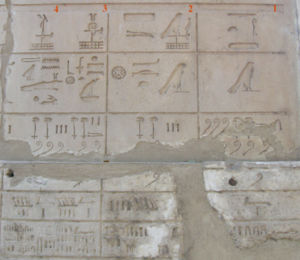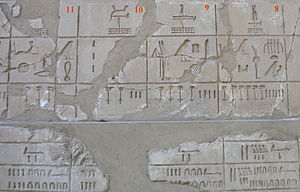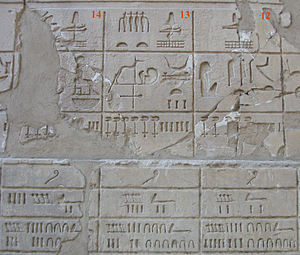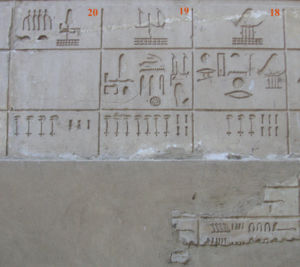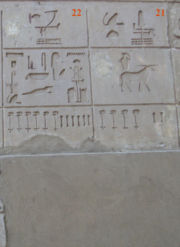Gauliste (Sesostris I.)

The Gauliste Sesostris' I is on the outside on the opposite side walls of the rebuilt White Chapel in the area of the open-air museum of the temple complex in Karnak . The list includes 22 Upper Egyptian and 16 (later there were 20) Lower Egyptian Gaue , also called nomos or districts in Greek.
Overview
The Gaue in the list are differentiated by Gauzeichen, the oldest are written on a standard, the younger ones are written without a standard. They have names and are designed as a bas-relief .
The purpose of the list was to create a land registry ; the naming of the main places and the gods venerated there served rather to identify the storage location of the measuring rope of each district, whereby the religious meaning of the chapel is undisputed. In order to be able to compare the cadastral data in the districts, the deviations in the length measurements (100 cubits ) of the respective districts from the 100 royal cubits from the king's residence were included in the district list, an early approach to standardization .
Such texts on the chapels, which were all erected on the occasion of a Sedfest , are also the content of the award document that is presented to the king when he ascends the throne .
For Sesostris I , the manifestation of the Gauges on a public building, the White Chapel , was obviously an important concern of the reorganization of the empire after a period of turmoil.
The geographical location of the Gaue of Upper and Lower Egypt is illustrated in the illustration opposite. "Shemau" refers to Upper Egypt and "To-Mehu" to Lower Egypt.
The list in detail
Its structure is explained in a legend at the end of the list (left column in the picture):
The top line of the list contains the Gau names.
The underlying designates the storage location of the measurement knits (literally bw nty [measuring knitting] jm , ie place where the measurement knitting is'): Named to the gods in whose temple he is kept, or their place of worship or the metropolis of the Gaus.
In the third line, the extent of the Gaus is essentially given in the unit (jtrw) Iteru (≈10.5 km), literally "river measure", i.e. measured along the Nile. In addition, there is information about the area in Cha (-Ta) (1 Cha (-Ta) = 10 Setschat = 27,250 m²).
Below that comes the approach to the comparability of the length measures used: in the cadastral text, the Gauss-specific deviations with regard to a length of 100 standard cubits are given.
Gaulist of Upper Egypt
| No. | Gau designation | Main deity / repository measuring rope | Gaul length, area | L. in km | image | ||
|---|---|---|---|---|---|---|---|
| 1 | (T3-stj) Bogenland , " Nubierland " | Island sign (jw) here: Elephantine / (Ḥr) Horus | 10.5 Iteru, 2 Cha | 112 |
|
||
| 2 | (Wṯst-Ḥr) Throne of Horus | (Ḥr-bḥdti) Horus Behedeti -city ( Edfu ) | 3 Iteru, 2 Cha | 33 | |||
| 3 | ( Nḫn ) landing site | Vulture Goddess (Nḫbt) Nechbet / City (Nḫb) Necheb ( Elkab , later Esna ) | 2.5 Iteru, 2 Cha | 27.4 | |||
| 4th | What-Gau ; (W3st) Thebes gr.Diospolis | War god (Mnṯw) Month / City Armant = Greek Hermonthis (later moved to Thebes ) | 3 Iteru, 2 Cha | 32.7 | |||
| 5 | Gaubez. is missing. (Nṯrwj) the two divine powers | Fertility god Min / City (Gbtjw) Koptos | 3 Iteru, 4 Cha | 32.7 |
|
||
| 6th | (Iqr) crocodile | Goddess (Ḥwt-Ḥr) Hathor / (nbt Jnt) mistress of the city Inet ( Dendera ) | 4 Iteru, 5 Cha | 44.6 | |||
| 7th | (B3t) Bat | Goddess Bat with Cow Head / City (B3tjw) Batiu (Diospolites) | 4 Iteru, 3 Cha | 43.6 | |||
| 8th | ( T3-wr ) Big country | Osiris Chontamenti (god of the west) / place of worship: (3bḏw), Abydos ; Metropolis: Thinis | 6 Iteru, 6 Cha | 67 |
|
||
| 9 | (Mnw) Minu | God Min / City (jpw) Ipu ( Panopolis ) | 4 Iteru, 4 Cha | 44.1 | |||
| 10 | Kobra (Wadjet) - Gau | Goddess Wadjet (Uto) / (unrecognized: City of Tjebu, Antaiopolites) | 3 Iteru, 2 Cha | 32.5 | |||
| 11 | Seth-Gau (unrecognized) | Gods Seth , Horus / City of Mjqr (Hypselites?) | ≤2 Iteru (estimate), 3 Cha | 22.8 | |||
| 12 | (3tft) Atefet (illegible) | (Lion-headed) goddess Matit / (City (J3kmt) , El-Ataula) | 5 Iteru, 6 Cha | 55.6 |
|
||
| 13 | (Nḏft-ḫntt) Front (southern) pomegranate tree | God Upuaut / City of Asyut | 6 Iteru, 6 Cha | 66.1 | |||
| 14th | (Nḏft-pḥt) Rear (northern) pomegranate tree | Goddess Hathor / city (kjs) (illegible) Cusae ; El-Qusiya | 3 Iteru, 6 Cha | 34.6 | |||
| 15th | Hasengau (Wnt) , very important | God (ˀh3) former name for god Bes , (main god Thot ), goddess (Wnwt) Unut / city (Ḫmnw) Hermopolis (magna) El-Ashmunein | 3 Iteru, 3 (?) Cha | 33.2 |
|
||
| 16 | ( M3-ḥḏ ) Oryx antelope -Gau ( Gazelle-Gau ) | God (Ḥr-Ḥbnw) Horus of Hebenu / City of Hebenu (Kom el-Ahmar?) | 4 Iteru, 7 Cha | 45.7 | |||
| 17th | (Jnpwt) Young dog (wbl.), Jackal | God Anubis / City (Ḥnw) Henu Kynopolis, El Qais | 4 Iteru, 3 Cha | 43.6 | |||
| 18th | Gau (ˁntj) Anti, Nemti "the clawed one" | God Nemti / City (Ḥwt-nswt) royal house , Kom el-Ahmar Sawaris | 6 Iteru, 3 Cha | 64.6 |
|
||
| 19th | Zepter-Gau (W3bwj) both scepter | God (W3bwjj) Seth / cities (Wnsj) belonging to the Gau , unlocated, and (Jˁq) , Oxyrhynchos | 4 Iteru, 7 Cha | 45.7 | |||
| 20th | Vorderer Nar-Baum- / Oleander-Gau (Nˁrt-ḫntt) | not preserved: God Herischef in the form of a ram (Greek Herakles) / city of Herakleopolis | 3 Iteru, 4 Cha | 33.6 | |||
| 21st | Rear Nar-Baum- / Oleander-Gau (Nˁrt-pḥwjt) | God (HNM) Khnum (Aries cult) / (lacking: City (Smnw-HR) geese of Horus ) | 3 (?) Iteru, 4 Cha | 33.6 |
|
||
| 22nd | (Mdnjt) Messer -Gau | Goddess (Nt) Neith , God (Sbk) Sobek , (at another place: cow head goddess Hathor ≈ Aphrodite / city (Tp-jḥw) Most noble of the cows , Greek Aphroditopolis) | 6 Iteru, 6 Cha | 66.1 |
The 22nd district contains the addition on the left in the second line of the picture: (š p šmˁw pḥ (wj)) Lake of the south, that is the rear ; the Fayum thus belonged to the 22nd district.
Gaulist of Lower Egypt
Regarding the Gaue sequence of Gaue 1 - 9 of Lower Egypt, the sources agree, then the Sesostris list deviates from the "canonical" sequence (here in brackets). Some descriptions of the custody have not survived.
| No. | Gau designation | Main deity / repository measuring rope | Gaul length, area | L. in km | image | ||
|---|---|---|---|---|---|---|---|
| 1 | Gau ( Jnbw-ḥḏ ) White Wall " City Wall " | God unclear, falcon cult (Horus) and local god Ptah (very respected) / city (Jnbw-ḥḏ) Memphis | 4 Iteru, 1 Cha | 42.5 |
|
||
| 2 | " Rinderschenkel " (Gau reading unknown) | God (Ḫntj-ḫm) Chentichem: First of Chem / City (Ḫm) Chem, Letopolis (Ausim) | 6 Iteru, 6 Cha | 66.1 | |||
| 3 | (Jmntt) West , Westgau | (Ḥpj) Hapi ( Horus son ), Greek Apis bull; as well as (Ḥwt Ḥr) Hathor / city (twt-jhjt) house of the cow " Rindergut " | 14 Iteru, 1 Cha | 147.5 | |||
| 4th | Gau (Nt-rsj) Südl. Neith-Gau | Goddess (Nt) Neith (archer) u. God (Sbk) Sobek (crocodile) / no place specified | 5 Iteru, 1 Cha | 52 |
|
||
| 5 | Gau (Nt-mḥti) Nördl. Neith-Gau | Goddess Neith? not specified / city (S3w) Sais | 1/2 Iteru, (improbable), 1 Cha | 5.8 | |||
| 6th | (Ḫ3sww) Wild bull | God (Rˁ) Re later Amun-Re , details unclear / city (Ḫ3sww) Chasu | 14 Iteru, 7 Cha (inexplicable number) | 150.7 | |||
| 7th | Gau (Wˁ-m-ḥww) Harpoon with rope (inscription above Gaue 7 and 8) Harpunengau , (gs jmnti) western half | God (Ḥ3) Ha (West God) / no place given | ≥ 5 Iteru | ≥ 52 |
|
||
| 8th | Gau ( W-m-hww-gs-j3b.tj ) Harpunengau , (gs-j3bj) eastern half | (God Atum ) not recognizable. / City (Ṯkw) Tjeku , Pithom (Greek Heroonpolis) | 4.5 Iteru, 6 Cha | 50.5 | |||
| 9 | Gau (ˁnḏtj) Anedjti “ God v. Pasture area "(figure with ruler's staff and flagellum) | God Osiris / City (Ḏdw) Busiris | 13? (15) Iteru, 1 Cha | 137.3 (158.3?) | |||
| 10 | lost: (Km-wr) Big wild bull | (God Chenti-cheti / city (Ḥt-ḥrt-ib) manor in the middle (of the delta) Atribis) | - | - |
|
||
| 11 | lost: (Ḥsbw) slaughtered bull | (God (Ḥr-mrtj) Horus with both aching eyes ) | - | - | |||
| 12 | lost: (Tb-nṯrt) calf of the goddess (cow) | (God Onoris- Schu / City (Tb-nṯrt) Sebennytos, Samanud) | - | - | |||
| 13 (15) | lost: (Ḏḥwtj) Ibis | (God (Ḏḥwtj) Thoth / place (Bˁḥ) Baqliya) | - | - | |||
| 14 (16) | Gau (Ḥ3t-mḥjt) First of the swimmers , fish symbol | No god specified, ( (B3-nb-ḏdt) Banebdjedet ) / place (Ḏdt) Djedet gr. Mendes | 12 Iteru, 6 Cha, 3 Setschat | 129.3 |
|
||
| 15 (13) | Gau (Ḥq3-ˁnḏ) ruler-healthy / healthy | Goddesses: Isis , Bastet / City (Sw) Su , Bubastis (Herodot) | 15 Iteru, 3 Cha, 4 Setschat | 159.3 | |||
| 16 (14) | Gau (Ḫntj-j3btj) front of the east part of the Ostgau | God: a Horus / city (Ḥwt-bnw) , Tanis ? | 3 Iteru, 2 Cha | 32.5 |
Additional information
At the time of Sesostris I, Lower Egypt was divided into only 16 (later 20) districts. Of the 22 available columns on the north side of the White Chapel, column 17 was used for the legend and columns 18 to 22 for further cadastral information.
-
Column 17 (legend of the previous list):
- Line 3: contains, as in column 22 of Upper Egypt, the unit of length (jtrw) Iteru for the figures without units in this line below the district.
- Line 4: (rḫt n sṯ3t) Directory of the Setschat .
- Line 5: What needs to be deducted from a setschat, subtract (ḫbj) .
- Row 6: remainder (ḏ3t) .
-
Columns 18 to 22
- Line 1: " (Bḥdt) Behdet on the extreme north side of the Gaue Unterägyptens up to the Memphitischen Gau at the beginning of the Gaue Unterägyptens."
- Line 2 + 3: Mythological height of the ideal flood for different regions and places
- Lines 4–6: Text about the length of Egypt, then in columns 20–22 measurement information (Iteru, hand width, finger; area measurement Cha)
See also
literature
- Wolfgang Helck , Wolfhart Westendorf (ed.): Lexicon of Egyptology. Volume 2: Harvest Festival – Hordjedef. Harrassowitz, Wiesbaden 1977, ISBN 3-447-01876-3 .
Web links
Individual evidence
- ↑ Adelheid Schlott-Schwab: The dimensions of Egypt according to ancient Egyptian texts (= Egypt and Old Testament. Vol. 3). Harrassowitz, Wiesbaden 1981, ISBN 3-447-02186-1 (also: Tübingen, Univ., Diss., 1968).


